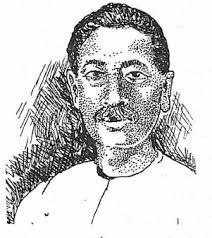In this post, notes of “Unit 1: the shroud by premchand summary” from “DSC- 12: Indian Writing in English Translation” are given which is helpful for the students doing graduation this year.
Biography of Premchand
Life and Works of Premchand:

Munshi Premchand (1880-1936) was an important Indian writer known for his work in Hindi and Urdu literature. He was born Dhanpat Rai in Lamhi, a village near Varanasi, India. He is seen as one of the greatest writers in Indian literature and is often called the “Emperor of Novels.” His stories focused on social problems, class struggles, the hardships of the poor, and the tough realities of life during British rule in India.
Premchand faced many personal and financial challenges in his early life, which made him care deeply about the struggles of ordinary people. His writings show his wish for social change and support for the rights of the less fortunate. He is well-known for short stories like “The Shroud” (Kafan), “The Idlers of the Storm” (Gharwapsi), and novels like Sevasadan and Godaan.
Besides being a writer, Premchand also worked as an editor for various magazines, using these platforms to support causes like caste reform, women’s rights, and the fight against British rule.
Overview of Urdu Literature:
Urdu literature has a rich history in the Indian subcontinent that began in the early 18th century. It grew from a mix of Persian, Arabic, and local Indian languages and became very important in South Asia’s culture. Early poets like Mirza Ghalib and Allama Iqbal are seen as key figures in Urdu literature. However, Urdu prose gained more attention in the 19th and early 20th centuries.
The short story genre in Urdu became very popular in the late 19th and early 20th centuries. Writers like Saadat Hasan Manto, Ismat Chughtai, and Premchand created stories that often focused on social issues, human relationships, and life’s challenges in a changing society. The British colonial rule and modernization greatly influenced Urdu literature during this time.
Context and Background of “The Shroud”

Historical and Cultural Context:
Munshi Premchand, the towering figure of modern Hindi and Urdu literature, never shied away from holding a mirror to society. His stories, steeped in realism, exposed the grim realities of caste, poverty, and human frailty in colonial India. Among his vast and celebrated oeuvre, one short story stands out for its sheer, uncompromising bleakness and profound philosophical depth: “The Shroud“ or “Kafan.”
First published in 1936, “The Shroud” is more than a story; it is an experience. It is a punch to the gut that leaves the reader breathless, not with sentimentality, but with a chilling, uncomfortable truth about the human condition when stripped of all dignity. It remains a seminal work, studied and debated for its brutal portrayal of how systemic oppression can erode the very essence of humanity.
Detailed Summary of “The Shroud”
The story is set in an impoverished Indian village and centers on a father and son, Ghisu and Madhav, who belong to the lowest ‘untouchable’ caste. They are the epitome of indigence and apathy. They are known in the village for their extreme laziness, working only when starvation is absolutely imminent, and often resorting to petty theft to survive.
The plot is triggered by a crisis. Madhav’s young wife, Budhiya, is in labor, writhing in agony inside their hut. Instead of helping her, Ghisu and Madhov sit outside under a tree, oblivious to her screams. Their primary concern is their own hunger. They discuss the impossibility of getting a doctor or midwife and resign themselves to their fate with a shocking passivity. Eventually, Budhiya’s screams cease—she and the newborn child die.
Their death presents a new problem. As per Hindu custom, a body must be wrapped in a new shroud (kafan) before cremation. Ghisu and Madhav own nothing. They have no money for a shroud. Reluctantly, they are forced to go and beg from the village landlords and officials.
After much pleading and enduring insults, they manage to collect a small sum of money—about five rupees—from the villagers, who donate out of a sense of religious duty rather than genuine compassion.
With the money in hand, their mission is to purchase the shroud. However, their path takes them past a liquor shop. The smell of food and alcohol proves irresistible. Initially hesitant, they soon convince themselves to have just a little drink. One drink leads to another. They use the donated money to buy alcohol and lavish fried snacks—a luxury they have never afforded in their lives.
As the alcohol takes effect, their spirits lift. Their sorrow and anxiety vanish, replaced by a drunken euphoria. They forget about the dead woman lying in the hut and indulge in a feast. In their inebriated state, they even philosophize their action. Ghisu argues that the shroud is a pointless ritual; it will only burn to ashes. What difference does it make if it’s cheap or expensive? Budhiya never had a good sari in her life; why would she care about a shroud in death? He concludes that their present enjoyment is a more fitting, tangible tribute to her.
The story ends on this devastatingly ironic note. The father and son, now drunk and full, are finally jolted back to reality. They remember the shroud, but the money is almost gone. They realize they can only afford a cheap, flimsy cloth now. The narrative leaves them in a state of drunken helplessness, laughing and crying, with no solution for the cremation that must happen at dawn.
Analysis: Layers of Meaning in the Bleakness
Premchand’s genius lies in his ability to weave complex social and existential themes into a simple narrative.
1. A Scathing Critique of Systemic Oppression:
“The Shroud” is foremost a brutal indictment of the caste system and extreme poverty. Premchand does not present Ghisu and Madhav as inherently evil villains. Instead, he portrays them as products of their environment. A lifetime of back-breaking labor for upper-caste landlords with no tangible improvement in their condition has broken their spirit. Their laziness is not a cause of their poverty but a consequence of it—a form of defeatist protest against a system that has shown them no mercy. They have learned that hard work does not lead to prosperity, only to more exploitation. Thus, they have surrendered to complete apathy.
2. The Dehumanizing Effect of Poverty:
The story explores how extreme deprivation can erode basic human emotions like empathy, love, and grief. The father and son’s reaction to Budhiya’s suffering and death is not one of tragedy but of inconvenience. Premchand forces us to ask a difficult question: Can those struggling merely to exist afford the luxury of grief? Their humanity has been so stripped away that their primal need for food and alcohol overrides the sacred social and religious duty of performing the last rites for a family member.
3. The Hypocrisy of Ritual vs. the Value of Life:
Premchand masterfully highlights the hypocrisy of societal norms. The village community, which did nothing to save Budhiya’s life, readily donates money for her shroud. This act is performed out of ritualistic obligation, not genuine compassion. The story critiques a society that values the performance of death over the preservation of life, especially the life of a low-caste woman.
4. Ironic Existentialism:
Ghisu’s drunken justification for using the money is one of the most powerful moments in literature. His argument—that their momentary pleasure is a more real tribute than a burning cloth—is perversely logical. It is a bleak, existential response to a meaningless life. In a world that has offered them nothing, they seize a rare moment of sensory pleasure. This act is a tragic rebellion against the absurdity of their existence and the emptiness of rituals that have never served them.
5. Symbolism of the Shroud:
The shroud (kafan) itself is a multifaceted symbol:
- It is a symbol of ritual that the protagonists cannot afford.
- It represents the final dignity in death that society believes in, but which Budhiya is ultimately denied.
- Ironically, it becomes a symbol of liberation—not for Budhiya, but for Ghisu and Madhav, liberating them temporarily from hunger and misery through the money it brings.
- In the end, its absence symbolizes the complete collapse of moral and social order in their world.
Conclusion: A Timeless Masterpiece
“The Shroud” is a difficult, unsettling story. It offers no redemption, no moral lesson, and no hope. And that is precisely its power. Premchand refuses to offer easy solutions or sentimentalize poverty. Instead, he presents a raw, unflinching look at its consequences.
It is a story that continues to resonate because the questions it raises are eternal. It challenges us to look beyond superficial judgments of “good” and “evil” and to understand the complex ways in which social structures can shape, and ultimately break, the human spirit. “The Shroud” is not just a story about two lazy men; it is a profound tragedy about a system that fails its most vulnerable, leaving them with nothing—not even the capacity to grieve. It is a masterpiece that continues to haunt the conscience of its readers.
What does the shroud symbolize in the book Kafan?
In Premchand’s “Kafan,” the shroud symbolizes the hollowness of ritual, societal neglect, and the dehumanizing effects of extreme poverty. It highlights the hypocrisy of a community that pays for a funeral cloth but ignores a person’s suffering in life. Ultimately, it represents how meaningless traditions become when humanity is lost.
What is the theme of Shroud?
The central theme of “The Shroud” is how extreme poverty and social oppression dehumanize people, crushing their empathy and reducing them to a mere struggle for survival.
What is the summary of the story Kafan by Premchand?
In the story “Kafan,” a poor father and son (Ghisu and Madhav) are very lazy. The son’s wife, Budhiya, is in pain giving birth, but they do nothing to help. She dies.
They need a shroud (a cloth to wrap her body for cremation) but have no money. They beg from the village and get some money.
Instead of buying the shroud, they use all the money to buy alcohol and food for themselves. The story shows how terrible poverty can make people lose their humanity.




There is a confusion in the summary, specifically in regard to the characters. Budhiya is the wife of Madhav, the one struggling in labour pain and who unfortunately dies due to neglect. Ghisu’s wife (mother of Madhav) dosnt have any place in the story. It’s a very short plot with few characters, why so much error?
Thanks for pointing that out! My apologies for the error. Budhiya is indeed Madhav’s wife, and Ghisu’s wife isn’t in the story. I’ve updated the summary to be accurate.